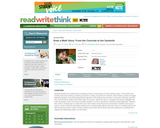
Students analyze their past readings and use that knowledge to create reading plans for the future.
- Subject:
- English Language Arts
- Material Type:
- Activity/Lab
- Lesson Plan
- Provider:
- ReadWriteThink
- Provider Set:
- ReadWriteThink
- Date Added:
- 06/05/2024

Students analyze their past readings and use that knowledge to create reading plans for the future.

Lights, camera, action, and a bit of mystery! In this lesson, students use mystery props in a skit bag to create and perform in short, impromptu skits.

Students collaboratively interact with a variety of texts as they define reading and develop their own Reader's Profiles modeled after online social networking sites.

Students compare the traits fact and fiction by using a Venn diagram to compare fiction and nonfiction books about Native Americans.

This online tool enables students to learn about and write diamante poems.

A read-aloud of Patricia Polacco's "Thank You, Mr. Falker" helps promote deeper comprehension through questioning to achieve personal connections and discussions of character and theme.

This lesson, in which students research worms in order to create a classroom habitat, incorporates reading and writing across content areas as well as math and science activities.

Striking images can leave lasting impressions on viewers. In this lesson, students make text-self-world connections to a nature- or science-related topic as they collaboratively design a multimedia presentation.

Striking images can leave lasting impressions on viewers. In this lesson, students make text-self-world connections to a nature- or science-related topic as they collaboratively design a multimedia presentation.

What's that sound? Students participate in a Directed Listening-Thinking Activity (DLTA) using "The Tell-Tale Heart," make predictions, and respond in the form of an acrostic poem or comic strip.

Students learn about memory by doing a memory-writing exercise, studying the brain to understand how it affects memory, reading Li-Young Lee's poem "Mnemonic," and creating projects to demonstrate their understanding.

Students read sonnets, charting the poems' characteristics and using their observations to deduce traditional sonnet forms. They then write original sonnets, using a poem they have analyzed as a model.

Through a study of Langston Hughes' poetry, students connect his writing to his place in history.

Doodle Splash combines the process of drawing with analytical thinking by pairing online drawing with writing prompts that encourage students to make connections between their visual designs and the text.

Students keep a doodle journal while reading short stories by a common author. In small groups, students then combine their doodles into a graphic representation of the text.

Draft letters ask students to think critically about their writing on a specific assignment before submitting their work to a reader. This lesson explains and provides models for the strategy.

Students create math stories by first drawing, then writing, and finally using math symbols to show addition or subtraction.

Students create math stories by first drawing, then writing, and finally using math symbols to show addition or subtraction.

Students draw a series of pictures that tell a story, including character action, problem and solution. They read their story to others, transcribe it into writing, and create an accordion book.

An Observation and Inquiry Sheet guides students as they analyze and compare their reactions to the value, engagement, and credibility of three websites related to Anne Frank and the Holocaust.